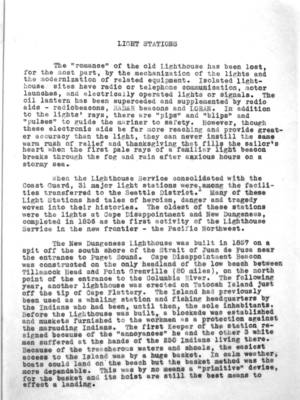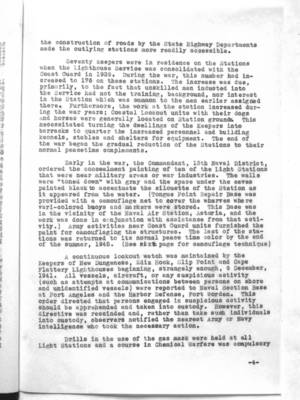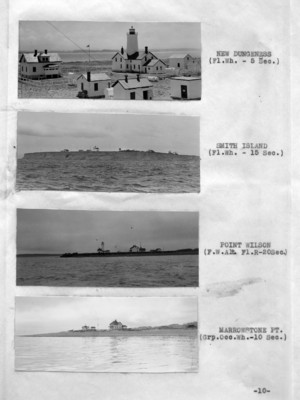Pages That Mention New dungeness
Coast Guard District narrative histories 1945
20
LIGHT STATIONS
The "romance" of the old Lighthouse has been lost, for the most part, by the mechanization of the lights and the modernization of related equipment. Isolated lighthouse sites have radio or telephone communication, motor launches, and electrically operated lights or signals. The oil lantern has been superceded and supplemented by radio aids - raidobeacons, RADAR beacons and LORAN. In addition to the lights' rays, there are "pips" and "blips" and "pulses" to guide the mariner to safety. However, though these electronic aids be far more reaching and provide greater accuracy than the light, they can never instill the same warm rush of relief and thanksgiving that fills the sailor's heart when the first pale rays of a familiar light beacon breaks through the fog and rain after anxious hours on a stormy sea.
When the Lighthouse Service consolidated with the Coast Guard, 31 major light stations were among the facilities transferred to the Seattle District.¹ Many of these Light Stations had tales of heroism, danger and tragedy woven into their histories. The oldest of these stations were the lights at Cape Disappointment and New Dungeness, completed in 1856 as the first activity of the Lighthouse Service in the new frontier - the Pacific Northwest.
The New Dungeness Lighthouse was built in 1857 on a spit off the south shore of the Strait of Juan de Fuca near the entrance to Puget Sound. Cape Disappointment Beacon was constructed on the only headland of the low beach between Tillamook Head and Point Grenville (80 miles), on the north point of the entrance to the Columbia River. The following year, another lighthouse was erected on Tatoosh Island just off the tip of Cape Flattery. The Island had previously been used as a whaling station and fishing headquarters by the Indians who had been, until then, the sole inhabitants. Before the Lighthouse was built, a blockade was established and muskets furnished to the workmen as protection against marauding Indians. The first Keeper of the station resigned because of the "annoyances" he and the other 3 white men suffered at the hands of the 250 Indians living there. Because of the treacherous waters and shoals, the easiest access to the Island was by a huge basket. In calm weather, boats could land on the beach but the basket method was the more dependable. This was by no means a "primitive" devise, for the basket and its hoist are still the best means to effect a landing.
23
the construction of roads by the State Highway Departments made the outlying stations more readily accessible.
Seventy keepers were in residence on the Stations when the Lighthouse Service was consolidated with the Coast Guard in 1939. During the war, this number had increased to 176 on these stations. The increase was due, primarily, to the fact that unskilled men inducted into the Service had not the training, background, nor interest in the Station which was common to the men earlier assigned there. Furthermore, the work at the station increased during the war years; Coastal Lookout units with their dogs and horses were generally located on Station grounds. this necessitated turning the dwellings of the Keepers into barracks to quarter the increased personnel and building kennels, stables and shelters for equipment. The end of the war began the gradual reduction of the Stations to their normal peacetime complements.
Early in the war, the Commandant, 13th Naval District, ordered the concealment of ten of the Light Stations that were near military areas or war industries. The walls were "toned down" with gray and the space under the eaves painted black to accentuate the silouette of the Station as it appeared from the water. (Tongue Point Repair Base was provided with a camouflage net to cover the wharves where vari-colored buoys and markers were stored. This Base was in the vicinity of the Naval Air Station, Astoria, and the work was done in conjunction with assistance from that activity.) Army activities near Coast Guard units furnished the paint for camouflaging the structures. The last of the stations was returned to its normal peace time color by the end of the summer, 1945. (See sixth page for camouflage technique)
A continuous lookout adwatch was maintained by the Keepers of New Dungeness, Ediz Hook, Slip Point and Cape Flattery Lighthouses beginning, strangely enough, 6 December, 1941. All vessels, aircraft, or any suspicious activity (such as attempts at communications between persons on shore (such as attempts at communications between persons on shore and unidentified vessels) were reported to Naval Section Base at Port Angeles and the Harbor Defense, Fort Worden. This order directed that persons engaged in suspicious activity should be apprehended and taken into custody. However, this directive was rescinded and, rather than take such individuals into custody, observers notified the nearest Army or Navy intelligence who took the necessary action.
Drills in the use of the gas mask were held at all Light Stations and a course in Chemical Warfare was complusory
29
(image 1)
NEW DUNGENESS (Fl.Wh. - 5 Sec.)
(image 2)
SMITH ISLAND (Fl.Wh. - 15 Sec.)
(image 3)
POINT WILSON (F.W.Alt. Fl.R-20Sec.)
(image 4)
MARROWSTONE PT. (Grp.Occ.Wh.-10 Sec.)


